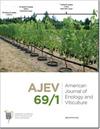Fruit Zone Shading to Control Grape Berry Temperature: A Modeling Study
IF 1.8
3区 农林科学
Q3 BIOTECHNOLOGY & APPLIED MICROBIOLOGY
引用次数: 0
Abstract
Recent increases in average air temperatures and heat wave intensity can present challenges in maintaining grape productivity and quality. As a result, growers are exploring approaches to protect berries from excessive temperatures, however, they can be costly and time-consuming to experimentally evaluate, and results may not be generalizable. In this work, we developed and evaluated a new 3-D model that can predict metrics related to berry temperature and light interception in response to varying vineyard architecture, topography, and shade cloth density. The resulting modeling tool was applied to better understand and evaluate a range of potential vineyard design and management practices for mitigation of elevated berry temperatures in vertically trained grapevines. Model validation showed close agreement between predicted and measured temperature dynamics, which responded appropriately to the application of shade cloth. In a simulation experiment, row spacing, row orientation, slope grade and aspect, and shade cloth density were varied to evaluate their effect on berry and canopy light interception, berry temperature spikes, and integrated berry heat accumulation. On flat terrain, a northeast-southwest row orientation provided the best compromise of berry light and temperature balance between opposing vine faces while avoiding excessive berry temperatures, while north-south rows provided good daily symmetry but had risk of high afternoon berry temperatures. The efficacy of shade cloth in mitigating excessive temperatures depended strongly on all variables considered. Slopes with southern or western exposure increased the imbalance in and risk of high berry temperatures, which in some cases could not be well-managed by shade cloth. Overall, the modeling tool appears capable of providing quantitative guidance for vineyard design and management where excessive berry temperatures are of concern.果区遮荫控制葡萄果实温度的模拟研究
最近平均气温和热浪强度的上升可能会给保持葡萄产量和质量带来挑战。因此,种植者正在探索保护浆果免受高温影响的方法,然而,这些方法的实验评估可能既昂贵又耗时,而且结果可能无法推广。在这项工作中,我们开发并评估了一种新的三维模型,该模型可以预测与浆果温度和光截获相关的指标,以响应不同的葡萄园结构、地形和遮荫布密度。由此产生的建模工具被应用于更好地理解和评估一系列潜在的葡萄园设计和管理实践,以缓解垂直培养葡萄藤中浆果温度升高的情况。模型验证表明,预测的温度动态与测量的温度动态非常一致,这对遮光布的应用做出了适当的响应。在模拟实验中,通过改变行距、行向、坡度和坡向以及遮荫布密度来评估它们对浆果和冠层截光、浆果温度峰值和浆果综合热量积累的影响。在平坦的地形上,东北-西南的行方向在避免浆果温度过高的同时,在相对的藤面之间提供了浆果光照和温度平衡的最佳折衷,而南北行提供了良好的日常对称性,但有可能出现下午浆果温度高的风险。遮荫布缓解高温的效果在很大程度上取决于所考虑的所有变量。暴露在南部或西部的斜坡增加了浆果高温的不平衡和风险,在某些情况下,遮荫布无法很好地控制这种情况。总的来说,该建模工具似乎能够为葡萄园的设计和管理提供定量指导,因为葡萄园的浆果温度过高。
本文章由计算机程序翻译,如有差异,请以英文原文为准。
求助全文
约1分钟内获得全文
求助全文
来源期刊

American Journal of Enology and Viticulture
农林科学-生物工程与应用微生物
CiteScore
3.80
自引率
10.50%
发文量
27
审稿时长
12-24 weeks
期刊介绍:
The American Journal of Enology and Viticulture (AJEV), published quarterly, is an official journal of the American Society for Enology and Viticulture (ASEV) and is the premier journal in the English language dedicated to scientific research on winemaking and grapegrowing. AJEV publishes full-length research papers, literature reviews, research notes, and technical briefs on various aspects of enology and viticulture, including wine chemistry, sensory science, process engineering, wine quality assessments, microbiology, methods development, plant pathogenesis, diseases and pests of grape, rootstock and clonal evaluation, effect of field practices, and grape genetics and breeding. All papers are peer reviewed, and authorship of papers is not limited to members of ASEV. The science editor, along with the viticulture, enology, and associate editors, are drawn from academic and research institutions worldwide and guide the content of the Journal.
 求助内容:
求助内容: 应助结果提醒方式:
应助结果提醒方式:


